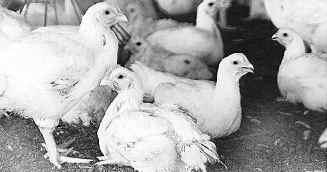 Like bacteria, various farm animals have been cloned to produce a variety of protein drugs that benefit humans. These protein drugs can counteract medical conditions such as anemia and diabetes and even some cancers. However, these cloned animals are expensive, large, and most take years before they can produce these desired protein drugs in sufficient commercially-viable quantities.
Like bacteria, various farm animals have been cloned to produce a variety of protein drugs that benefit humans. These protein drugs can counteract medical conditions such as anemia and diabetes and even some cancers. However, these cloned animals are expensive, large, and most take years before they can produce these desired protein drugs in sufficient commercially-viable quantities.
However, some researchers have decided that chickens can be desirable protein drug factories because they are small, inexpensive and have rapid generation times. Further, chickens could produce neat packages -- eggs -- that are loaded with these desired protein drugs.
Simon Lillico of the Roslin Institute outside Edinburgh, Scotland, and his colleagues, led by the Roslin Institute's Helen Sang, constructed drug-coding protein genes that inserted themselves into the gene that all chickens carry for making the egg-white component, ovalbumin. So instead of producing ovalbumin, the chicken would produce the protein drug of interest. Because egg whites are composed primarily of ovalbumin, this means that these eggs could instead be loaded with the protein drugs of interest.
The team cloned two protein genes into chicken albumin gene; an antibody called miR24, which has shown promise against melanoma, and a protein gene called human interferon-beta-1a, which is already used to treat multiple sclerosis. The researchers used viruses to place the genes into cells in young chick embryos inside unhatched eggs.
When the eggs hatched, the researchers selected the male chicks that carried the altered gene. When the team later bred these roosters with normal hens, half the female offspring laid eggs containing both protein drugs in their [egg] whites, the researchers report in an upcoming Proceedings of the National Academy of Sciences. The researchers continue to screen for male offspring carrying the genes and to breed them with normal hens. They now have five generations of drug-producing birds, Lillico says.
The newly engineered chickens "could pave the way to something very interesting," says animal sciences professor François Pothier of Laval University in Quebec City, who has engineered pigs to produce useful proteins in their semen. Pothier points out that before chickens roost in pharmaceutical factories, the researchers in Scotland have many hurdles to overcome, such as increasing the small amounts of the two drugs present in the hens' egg whites.
"You can imagine that eventually, not only could you modify the content of an egg for therapeutics, but you could perhaps change the flavor or add something interesting for health," such as vitamins or heart-healthy fatty acids, Pothier says.
Cited story.
- Log in to post comments

Of course they (and 3-4 other labs around the world doing the same thing) needed to do something practical first, in order to get the millions in grant money needed to do this. But now that they have the technique down pat, there is only one more step towards making genetic knockout or transgenic birds for research, thus making birds, once again, prime lab models for some types of studies!
According to the abstract of the paper the authors actually generated transgenic chicken. However, the generation of KO requires several other steps at least when you want to do gene targeting which relies on homologous recombination. The only thing that could be achieved by their technique (lentviral gene transfer) would be post-transcriptional gene silencing via RNA interference which of course would be a nice tool. RNA interference in mice does work (even conditionally) but has some problems: In most cases the knock down is less the 100% (you would be lucky if you achieved 90%), off target effects are a severe problem and not predictable and knock down efficiency may drastically vary in different tissues.
Lentiviral gene transfer is another problematic issue: AFAIK, lentivirus based expression systems in mice tend to get inactivated after a few generations. In addition, since the integration of such constructs is random it may interfere with the function of an endogenous gene. Another issue is the limited packaging capcity of such constructs that limits the size of proteins to be expressed.
BTW, it is possible to make gene targeting based KOs in a chicken cell line (DT-40). Unfortunately, this cell line was derived from a B-cell. Thus, it can not be used to generate KO chicken.
I know it is not that simple, but major, MAJOR obstacles have been removed in figuring out how to do this in birds. "One step" was a metaphor for "not going to be so difficult any more" to create a KO now that a transgenic has been made in a couple of labs already (Roslin Insitute, Jim Petitte at NCSU and one other place also was successful recently I believe).
When I saw this article it reminded me of a case here in my area of Ohio...the eggs involved and the people using the product was being shouted as a breakthrough for treatment as a dietary additive but label differently and now out of business. Dr.Colemans' dreams are down the drain. How sad! check it out here: http://pro-networkers.com/bbs/messages/10116.html